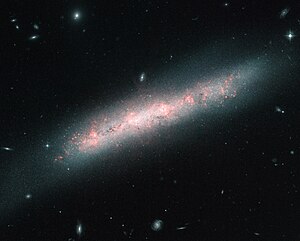NGC 4700
| Galaxy NGC 4700 |
|
|---|---|

|
|
| Photo from the Hubble Space Telescope . An active star formation takes place in the reddish glowing Hα regions. | |
| AladinLite | |
| Constellation | Virgin |
|
Position equinox : J2000.0 , epoch : J2000.0 |
|
| Right ascension | 12 h 49 m 08.1 s |
| declination | -11 ° 24 ′ 35 ″ |
| Appearance | |
| Morphological type | SB (s) c? / HII / Sy2 |
| Brightness (visual) | 12.1 mag |
| Brightness (B-band) | 12.8 mag |
| Angular expansion | 3.2 ′ × 0.8 ′ |
| Position angle | 48 ° |
| Surface brightness | 13.0 mag / arcmin² |
| Physical data | |
| Affiliation |
NGC 4594 group LGG 307 |
| Redshift | 0.004700 ± 0.000013 |
| Radial velocity | 1409 ± 4 km / s |
|
Stroke distance v rad / H 0 |
(58 ± 4) · 10 6 ly (17.7 ± 1.2) Mpc |
| history | |
| discovery | William Herschel |
| Discovery date | March 25, 1786 |
| Catalog names | |
| NGC 4700 • PGC 43330 • MCG -02-33-013 • IRAS 12465-1108 • 2MASX J12490814-1124354 • GC 3230 • H III 524 • h 1438 • h 3426 • HIPASS J1249-11 • LDCE 904 NED255 | |
NGC 4700 is an active barred spiral galaxy with extensive star formation from Hubble type north SBc in the constellation Virgo the ecliptic . It is estimated to be 58 million light years from the Milky Way and about 60,000 light years across .
The galaxies NGC 4680 and NGC 4708 are located in the same area of the sky .
The object was discovered by William Herschel in March 1786 and described as “very faint nebula”.
Web links
Commons : NGC 4700 - collection of images, videos, and audio files
- SIMBAD Astronomical Database
- astronews.com: Picture of the day July 23, 2012
